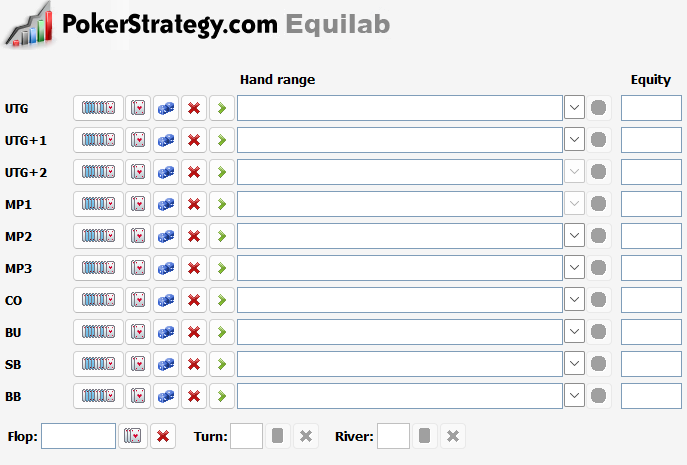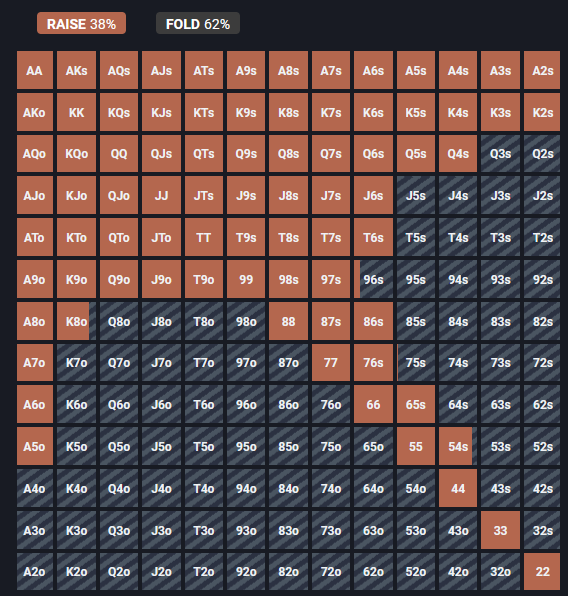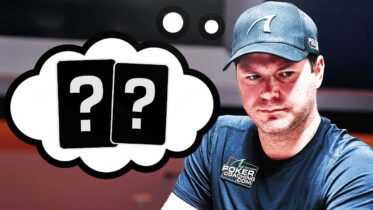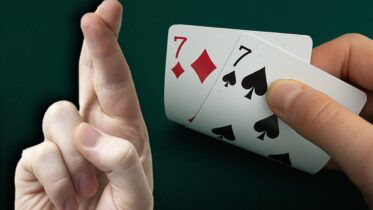There used to be a time when poker players relied on their gut feeling and live tells more than anything else, but that time is certainly past. While such things still play a role in modern poker, they have been outshined by fundamental strategies, most of which are mathematical in nature.
The appearance of the first poker solvers on the market completely changed the way average players see the game.
Over the years, poker solvers have helped thousands of players significantly improve their games, with many of the younger generation having solvers to thank for all their success in the game.
But what are poker solvers exactly, and how can they help you become a better player? If you came here wondering, you are in the right place, as we are about to answer all your questions about solvers in poker.
What Are Poker Solvers?
Poker solvers are modern tools used to calculate Game Theory Optimal strategies, also referred to as solves, solutions, or solver outputs.
Poker solvers were not always a part of the poker world, and they have, in fact, only risen to prominence over the last several years, especially on a massive scale.
Poker solvers are programs you can use to run simulations of poker hands in order to learn the optimal gameplay strategy for given scenarios.
These tools require you to enter a number of inputs, which describe the hand you are looking to solve and which are used to run the calculation.
Contrary to popular belief, poker solvers don’t actually know how to play poker but rather use a set of simulations from the beginning each and every time they run a hand, adjusting strategies through trial and error until they reach a Nash Equilibrium solution, which is perfectly balanced.

Equilab is a free poker solver that can help you study the equities of different ranges and hands.
Game Theory Optimal (GTO) Poker Strategy
Like we just said, poker solvers are tools designed to come up with GTO poker solutions, but what exactly are those, and what does GTO stand for?
GTO poker refers to a mathematically perfect way of playing poker, one that cannot be exploited by your opponents, regardless of how they play their hand.
The goal of GTO strategies and poker solvers is to create a way of playing that will always make you at least break even against any player in the world.
This makes the GTO poker strategy extremely appealing, as it guarantees you will not be a losing poker player, regardless of who you face.
Of course, humans can’t mimic this kind of GTO approach to perfection, and even poker solvers can only provide you with solutions for a given set of inputs you feed into them.
Furthermore, the GTO is not always the best way to play a particular hand, as it does not attempt to exploit the player you are playing against, either.
What this means is that there are quite a few scenarios in which deviating from GTO can lead to a higher profit but at a risk of being exploited by other players.

One of the best poker players in the world under the age of 30,
PokerCoaching.com coach Justin Saliba has built a career off of playing a GTO poker strategy.
Using Poker Solvers
Now that you know what poker solvers are, it is time to learn more about how you can use them to study poker and improve your poker skills.
There are a few things to remember before you start running your first solve, and perhaps the most important is that solvers always operate in terms of poker ranges.
If you want to run a simulation, you will need to feed the solver with your own possible range in a scenario, as well as a realistic range of hands for your opponent. Therefore, if you make mistakes with this part and provide the solver with inaccurate inputs, the outputs you get will be equally faulty.
That said, here are the basic steps you will have to go through every time you want to run a solver for one of your hands:
Step #1 – Building a Game Tree
Building a game tree is the first part of the process of using a poker solver to solve a hand. Game trees are graphical representations of all the possible actions in a hand, or rather, the ones you choose to include.
Keep in mind that poker is a game of almost infinite possibilities. For this reason, you will need to tell the solver which possibilities you wish it to solve for and include in the game tree.
For example, you will need to determine which bet sizes both you and your opponent might want to use on different flops or turns.
Normally speaking, players will run simulations for a popular bet and raise sizes such as 33% of the pot, 60% of the pot, full pot, etc.
Game tree builder within your poker solver will help you out with this, but it will also take some time before you build those elite game trees.
Keep in mind that the more decision nodes you add to the game tree, the longer your solve will take, so it’s a good idea to limit those to a few on every street, as suggested by the game tree builder.
Step #2 – Input the Ranges
As we already explained, poker solvers don’t actually know how to play poker, and they don’t know the first thing about which hands you might want to play from any position. Therefore, it will be necessary for you to input your own range and your opponents’ ranges into the solver.
For your own range, you should enter a realistic range that you know you would play in a given scenario. By all means, be honest with yourself when doing this part.
Next, you will want to input a range for your opponent or multiple players. In this case, you will need to use experience or some premade hand ranges that best fit population tendencies.
Inputting the right hand ranges is equally as important as creating a reasonable game tree, as both will have a big impact on the final outcome of your solution.
Step #3 – Run the Solve
Once all the relevant data has been input, all that’s left is to run the solver and wait for the computer to crunch the numbers.
Poker solves can take quite a bit of time, especially if you want perfect results. For that reason, solvers will let you stop just short of Nash Equilibrium, saving a ton of time for just a slight inaccuracy.
The process in which poker solvers come up with solutions is quite an interesting one, especially for the nerds who wonder how exactly this happens.
Since poker solvers don’t know how to play poker, they will run a great number of simulations, starting with a completely random poker strategy for all players involved.
As the solver runs through more and more simulations, it will adjust the strategy of both players until it reaches a perfect balance.
The final results of a poker solution will be perfectly balanced ranges for the given scenario. Mimicking these ranges in real games will make you unexploitable and virtually unbeatable.
Step #4 -Interpreting the Solver Outputs
Once you have run a solve in one of the popular poker solvers, the tool will tell you which portions of your range you should use for each of the options you provided in the game tree.
For instance, if you told the solver to create a strategy that involves a flop check, a 33% pot bet, and a 100% pot bet, it will tell you which hands in your range you should be using for each of those three actions.
This is where it gets a bit tricky, though! Unlike a human player, a poker solver will often use a “mixed strategy,” which means it will tell you to check a certain hand x% of the time while betting it x% of the time.
With a mixed strategy used for many hands, actually mimicking the results of a poker solve in a real game would be nearly impossible.
However, if you are going to try and play a strategy that resembles GTO, you will need to learn about randomization and mixing it up with certain hands in your range to actually remain balanced.
Using Premade Poker Solves
A whole generation of young poker players these days gets to benefit from all the work some of the top players out there have done with solvers over the years.
One great example of this is solved preflop ranges, which typically take an extremely long time to process and usually can’t even be done on a home computer.
Thankfully, preflop ranges have already been run through computers over and over again, and you will have no problem finding readily available preflop poker charts made in accordance with the GTO poker approach.
Preflop charts are available for open raises from all positions, 3-bets from and against all positions, and more, making it very easy for you to start learning them without having to run the sims.
Premade GTO solutions for postflop situations are also available out there, so if you want to save yourself some time, you may want to consider purchasing a subscription to one of the databases containing these, which will give you the solutions you were looking for immediately.

GTO preflop charts, like the ones found on PokerCoaching.com, allow users to implement solver approved ranges.
Should I Use Poker Solvers?
So should you be using poker solvers or not? The quick answer is YES. If you want to become a better poker player, poker solvers are almost definitely the most useful tool out there, so you can play with it directly or study via training videos that analyze various spots.
Poker solvers technically teach GTO poker, but even if you are not looking to learn this strategy and try to copy the tools, playing around with solvers to understand the fundamentally right approach will make you a better player.
Simply running the simulations, thinking about all the possible hand ranges and plays that can be made, and seeing how the solver comes up with its solutions will help you improve your understanding of the game.
Once you are able to remember what solvers do in some common spots, you will know the GTO baseline for these spots, and you will be able to adequately deviate from it based on your in-game observations.
In either case, we highly recommend doing at least some solver work if you are serious about poker, and we can promise you that it will be helpful if you give it a bit of time and effort it deserves.



